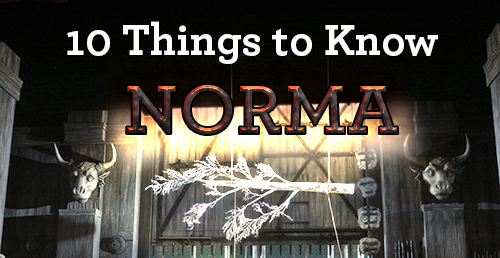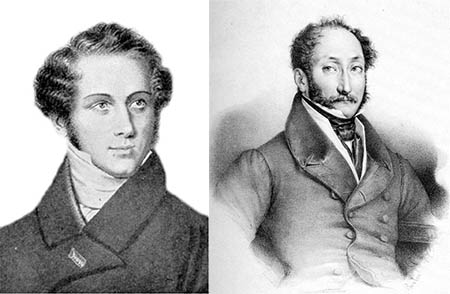-
10 Thing to Know: Norma
By COC StaffPosted in NormaBy Gianmarco Segato, Adult Programs Manager

Vincenzo Bellini's Norma, the iconic bel canto masterpiece is set to hit the stage at the Four Seasons Centre for the Performing Arts and kick off the 2016/2017 season. Do you need a quick introduction or a refresher course on some key concepts? Here are 10 Things to Know before you go!
1. PLOT IN A MINUTE
Norma, a druid priestess, is torn between love for those she leads, and a secret passion for Pollione, the Roman enemy of her people. She has two children with him in secret before discovering he has begun an affair with her younger acolyte, Adalgisa. Norma forgives Pollione in the end, and he joins her in her fiery destiny.
2. ALL THE GREAT THEMES
Norma brings together all the great dramatic themes that dominate Italian opera: love (Norma loves her enemy, Pollione, head of occupying Roman forces); jealousy (the love triangle between Norma, Pollione and Adalgisa); friendship (Norma and Adalgisa maintain their friendship despite being in love with same man); conflict between nations (Druids versus Romans), motherhood (Norma has two children by the faithless Pollione) and finally, sacrifice (Norma commits suicide, wracked by guilt for having betrayed her people).
3. YOU SAY ‘DECLAMATO,’ I SAY ‘FIORITO’
Bellini pioneered canto declamato (declamatory singing)—a style of vocal writing that kept the orchestral accompaniment relatively simple, allowing the audience to pay greater attention to the relationship between text and melody. This was in opposition to his Italian bel canto predecessor Rossini who opted for a more florid style referred to as canto fiorito (flowery singing).
4. IT’S ALL ABOUT THE DRAMA!
Norma may be best known for the restrained, languid aria “Casta diva,” but it is also packed with searing drama, nowhere more so than the opening of Act II where Norma contemplates killing her children in order to seek revenge against their father, Pollione, who has abandoned her for her best friend, Adalgisa.
5. THE HEROINE TAKES OVER
In the period directly preceding the bel canto era (Norma premiered in 1831), opera was dominated by the castrati, male sopranos worshipped for their extraordinary vocal technique. They were the stars of late 18th-century opera seria where vocal virtuosity took precedence over dramatic values. By Bellini’s time however, female singers became the new stars and roles like Norma set a new standard, placing equal value on dramatic veracity as well as ironclad vocal technique.
6. WANTED: SINGING ACTRESS
From the start, the great Normas of operatic history have all been great singing actresses: mistresses of astonishing vocal technique and outstanding personalities. The first Norma, soprano Giuditta Pasta, was lauded for her power to combine all the “several excellences of the drama, the opera and the ballet; mind, voice and action” into a complete performance. In the 20th-century, the gold standard Norma was Greek-American soprano, Maria Callas who in 1958 made headlines when she notoriously walked out of a performance of Norma in Rome, despite the presence of the Italian president.
Above: Sondra Radvanovsky in a scene from the COC's production of Norma (San Francisco Opera, 2014)
7. TAILOR-MADE
As was customary in Bellini’s time, opera roles were tailor-made to suit the talents of their original interpreters. Tenor Domenico Donzelli, the first Pollione, was very specific about his attributes when he wrote to Bellini: “The range of my voice then is nearly 2 octaves, from low D to top C. Chest voice to G and it is in this range that I can declaim with vigor and sustain all the force of the declamation. From G to high C, I can use a falsetto that, employed with art and with power, provides a means of decoration. I have a fair amount of agility, but find descents much easier than ascents.” Bellini took this to heart, filling the role with full-voiced G’s, just one “decorative” high C, and runs that mainly took the tenor’s voice downward.
8. MELODRAMA!
Bellini’s signature style prioritized the text, allowing it to dictate how he shaped the vocal line. This school of composition was referred to as melodramma—not in today’s pejorative, “soap opera” meaning of the term, but rather, to signify “drama as revealed in melody” and to distinguish it from the stiffer, formalized opera seria of the 18th century.
9. CONTEMPORARY RESONANCE
A tragic clash of cultures is central to Norma in which imperialistic Roman forces occupy the Druids in Gaul. Contemporary Italian audiences would have recognized in this conflict their own struggle to oust their Austrian oppressors who at the time were sending in troops to put down revolts against their domination.
10. TEAMWORK!
The team of Bellini and his librettist, Felice Romani, was one of the great collaborations of operatic history. The composer simply refused to take on commissions unless Romani was on board to write the text. Bellini’s devotion bordered on obsessiveness as he recounted in his later years: “It seemed impossible for me to exist without you…write for me alone; only for me, for your Bellini”.

Above: Vincenzo Bellini (left) and Felice Romani (right)
Norma is running from October 6 to November 5. For more information and tickets, please click here.
Photo credits (top - bottom): a scene from Norma (San Francisco Opera, 2014), photo: Cory Weaver; Sondra Radvanovsky (far right) as Norma in Norma (San Francisco Opera, 2014), photo: Cory Weaver
